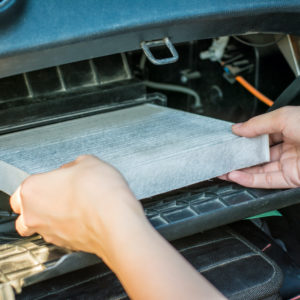All vehicles—except for those that are front-wheel drive—use one or more driveshafts to transfer rotational force from the transmission (or transfer case) to the differential (s). A driveshaft is essentially a long shaft comprised of tubes, joints, and (in some cases) a center support bearing.
Although the entire driveshaft rarely fails, its bearing and joints can wear out over time. When that happens, it’s almost always easier to replace the entire driveshaft instead of the individual parts. There are also some driveshafts that are not serviceable and must be replaced as an assembly.
Whatever your reason for needing a driveshaft replacement, if you’re handy, you may want to consider doing the job yourself. Replacing a driveshaft is usually a relatively straightforward affair if you have the tools and the know-how.

How to Replace a Driveshaft
The procedure for replacing a driveshaft will vary, depending on the year, make, and model of the vehicle. Because of this, it’s important to consult the replacement instructions for your application in a repair manual or repair database.

But for a general overview of what replacing a driveshaft typically involves, check out the information below.
Tools and Equipment Needed to Replace a Driveshaft
The tools needed to replace a driveshaft will vary, depending on the type of vehicle you have.
In general, however, you’ll need:
- Chassis grease
- Fluid catch pan
- Ratchet and socket set
- Repair manual or access to a repair database
- Safety glasses
- Torque wrench
- Wheel chocks
- White Out (also known as Liquid Paper)
- Wrench set

Driveshaft Replacement Instructions
Now, let’s get started replacing your driveshaft. The following steps will give you an idea of what the job typically entails.
Note: The following are general guidelines for educational and entertainment purposes only. Consult your vehicle’s factory information for specific repair instructions and recommended safety procedures.
How to Remove a Driveshaft
- Put on your safety glasses.
- Safely raise and support the vehicle using a jack and jack stands. Set the parking brake and chock the rear wheels.
- Use White Out to make alignment marks between the driveshaft and the differential’s pinion flange, as well as the driveshaft and the transmission or transfer case. You’ll need to know the driveshaft’s position in relation to the rest of the drivetrain to reinstall the driveshaft properly.
- Put a fluid catch pan under the output seal at the end of the transmission or transfer case. A small amount of fluid may leak out of the seal area when you remove the driveshaft.
- Remove the fasteners and yoke retainers that secure the driveshaft to the differential’s pinion flange.
- Slide the driveshaft forward to disengage it from the pinion flange.
- Lower the driveshaft to slide its yoke out of the transmission or transfer case.
- Remove the driveshaft from the vehicle.

How to Install a Driveshaft
- Compare the new driveshaft to the old driveshaft to ensure both are the same design.
- Apply a light coat of chassis grease to the slip yoke splines.
- Reinsert the driveshaft’s yoke into the transmission or transfer case by sliding it over the output shaft. Make sure that the alignment marks you made earlier match up with the same location on the new driveshaft.
Note: Be careful not to damage the output seal while inserting the yoke into the transmission or transfer case. - Pull the driveshaft back toward the pinion flange and mount it in place.
- Reinstall the fasteners and the yoke retainers that secure the driveshaft to the differential’s pinion flange. Make sure that the alignment marks you made earlier match up with the same location on the new driveshaft.
- Use a torque wrench to tighten the driveshaft’s fasteners to the manufacturer’s specification.
- Safely remove the jack stands and lower the vehicle.
- If a substantial amount of fluid came out while you were removing the driveshaft, check the fluid level in the transmission or transfer case and top it off as needed.
The video below demonstrates what removing a driveshaft typically involves:
You can also watch this video to get an idea how to replace a rear driveshaft:
How Much is a Driveshaft?
If you choose to have a professional replace your driveshaft, you can usually expect to pay somewhere between $700 and $2000 to get the job done.
But you can save money by replacing the driveshaft yourself if you have the tools and know-how. Most replacement driveshafts cost somewhere between $300 and $800. Of course, the exact price will depend on various factors, such as the year, make, and model of your vehicle.
Any information provided on this Website is for informational purposes only and is not intended to replace consultation with a professional mechanic. The accuracy and timeliness of the information may change from the time of publication.





























